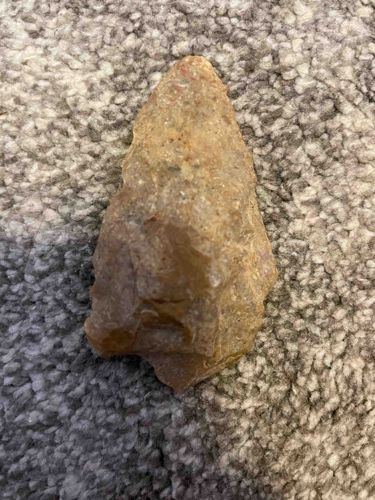
Prehistoric Stone Tool (Projectile Point/Hand Axe)
The item appears to be an ancient stone tool, possibly a projectile point or a hand axe, crafted from a light brown or tan chert or flint-like stone. It is roughly triangular in shape with a pointed tip and a broader base, though the base is not fully visible in the provided image. The overall texture of the stone is somewhat coarse and granular, suggesting a type of quartz or chert with visible inclusions. The color is predominantly a subdued earthy tone, ranging from light brown to tan, with some areas exhibiting reddish or darker brown specks, possibly mineral inclusions or staining from its environment. The craftsmanship, though simple, indicates intentional flaking or knapping to create sharp edges and a pointed form, characteristic of lithic tools made by early human cultures. The edges show signs of wear and chipping, which could be from use, patination over extended periods, or minor post-excavation damage. There are no discernible modern manufacturing marks, signatures, or stamps, aligning with its assumed ancient origin. Its age is estimated to be prehistoric, likely from the Stone Age, given its material and construction method. The item exhibits a natural patina consistent with prolonged exposure to the elements and burial, contributing to its aged appearance. There are no obvious signs of recent repair, and its condition appears stable despite the wear. The quality of craftsmanship, while not showcasing intricate designs, demonstrates functional effectiveness for its intended purpose, which was likely cutting, scraping, or as a weapon component.
AI-Generated Appraisal Disclaimer
Estimated Value
$250 - $400
Basic Information
Category
Ancient Tool / Artifact
Appraised On
December 3, 2025
Estimated Value
$250 - $400
Item Description
The item appears to be an ancient stone tool, possibly a projectile point or a hand axe, crafted from a light brown or tan chert or flint-like stone. It is roughly triangular in shape with a pointed tip and a broader base, though the base is not fully visible in the provided image. The overall texture of the stone is somewhat coarse and granular, suggesting a type of quartz or chert with visible inclusions. The color is predominantly a subdued earthy tone, ranging from light brown to tan, with some areas exhibiting reddish or darker brown specks, possibly mineral inclusions or staining from its environment. The craftsmanship, though simple, indicates intentional flaking or knapping to create sharp edges and a pointed form, characteristic of lithic tools made by early human cultures. The edges show signs of wear and chipping, which could be from use, patination over extended periods, or minor post-excavation damage. There are no discernible modern manufacturing marks, signatures, or stamps, aligning with its assumed ancient origin. Its age is estimated to be prehistoric, likely from the Stone Age, given its material and construction method. The item exhibits a natural patina consistent with prolonged exposure to the elements and burial, contributing to its aged appearance. There are no obvious signs of recent repair, and its condition appears stable despite the wear. The quality of craftsmanship, while not showcasing intricate designs, demonstrates functional effectiveness for its intended purpose, which was likely cutting, scraping, or as a weapon component.
Related Tags
Get Your Items Appraised
Instant estimates of your treasures with AI-powered instant appraisals